With the best Panasonic camera in your hand, you’ll be able to shoot stunning photos and videos. Panasonic Lumix makes a wide range of cameras. They have everything from full frame mirrorless cameras to compact cameras. They have great cameras for beginners. And there are Panasonic cameras for multimedia professionals.
The Panasonic Lumix GH6 is the best Panasonic camera right now. The photography specs are excellent for a Micro Four Thirds (MFT) camera. And there’s even a High-Res Shot mode for more power. But the real appeal lies in its outstanding video features. It’s the ultimate hybrid camera for multimedia producers.
What Is the Best Panasonic Camera?
Panasonic Lumix is a specialist brand that makes incredible hybrid cameras. They deliver outstanding photography results. But the video options are just as impressive.
They produce a wide range of different cameras. But each one gives you excellent photo and video options. Panasonic cameras are popular with photographers and videographers.
Panasonic Lumix has a fantastic range of cameras available. They are masters of the Micro Four Thirds cameras. This type of camera has a smaller sensor than APS-C or full frame ones.
This means they have lighter and more compact bodies. And despite their size, they still deliver superb results. You can see our full article on the best Micro Four Thirds cameras if you’re looking for a smaller camera.
The advanced hybrid features make full frame cameras popular with professionals. But they also have cameras for photographers at lower levels. You can’t go wrong with a Panasonic Lumix compact camera.
And their bridge cameras are perfect for beginners. There’s a Panasonic camera for everyone, from photographers to videographers and beginners to pros. So here’s a quick rundown of our list. It has a brief intro to each Panasonic camera.
You can find a full description of all the Panasonic Lumix cameras in the section after. And the article ends with a FAQ section. We recommend reading that if you need more information on Panasonic Lumix cameras.
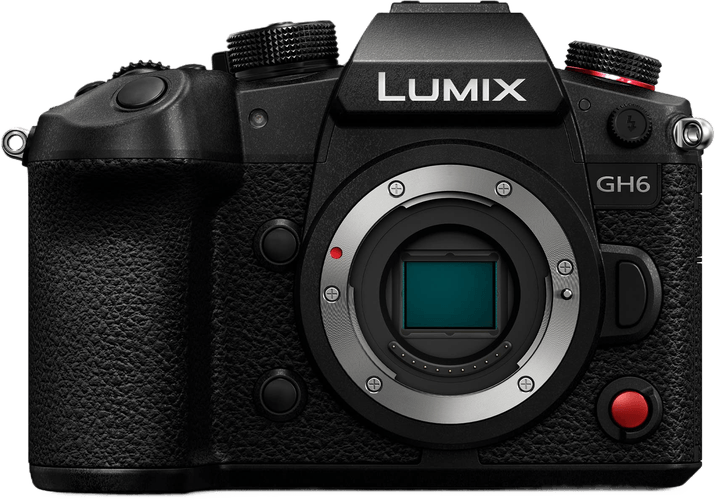
- 25 megapixel (MP) resolution and MFT sensor
- 4K / 60p video recording
- Advanced Depth from Defocus (DFD) autofocus
- 5-axis dual image stabilization (IS 2)
- 100 MP high-resolution shot mode

- Outstanding image quality and dynamic range
- 6K / 30p and 4K / 60p video
- Active image stabilization for sharper video
- 50 ISO setting for ultimate quality
- Real-time LUT functionality for vibrant color
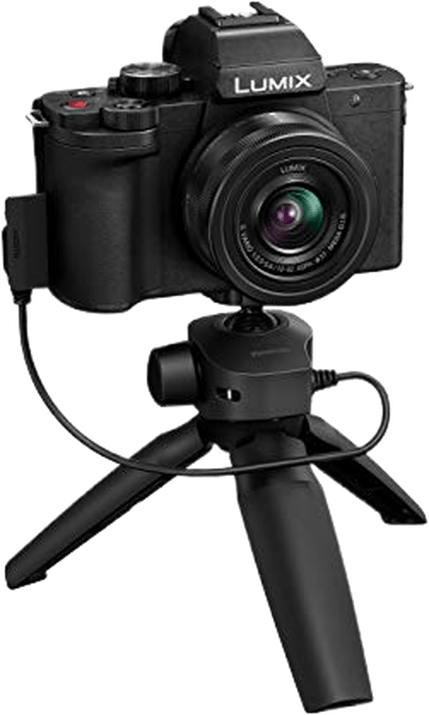
- Quality 20.3 MP MFT sensor
- High-quality 4K video recording
- 5-axis hybrid image stabilization for video
- 3.0" tilting LCD touchscreen
- Compact and lightweight design
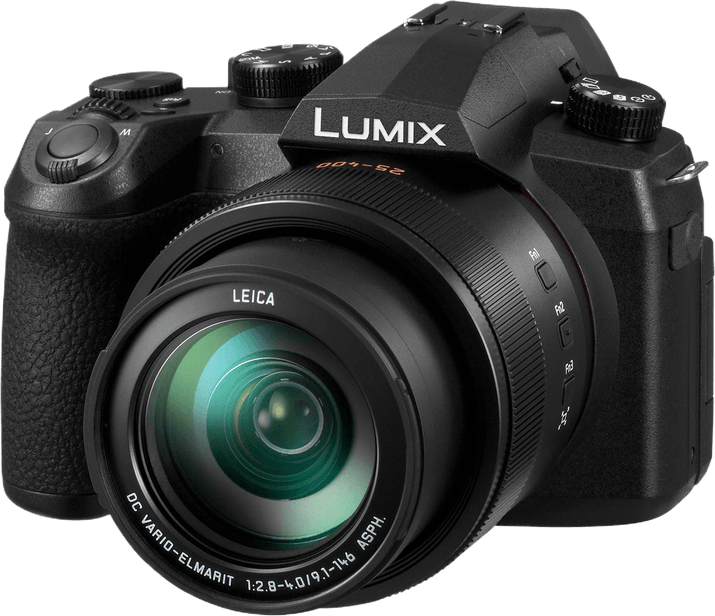
- 20.1 MP 1-inch high-sensitivity sensor
- 4K video and and photo modes
- Leica f/2.8-4.0 16x optical zoom lens
- 5-axis hybrid image stabilization
- Built-in Wi-Fi and Bluetooth connectivity
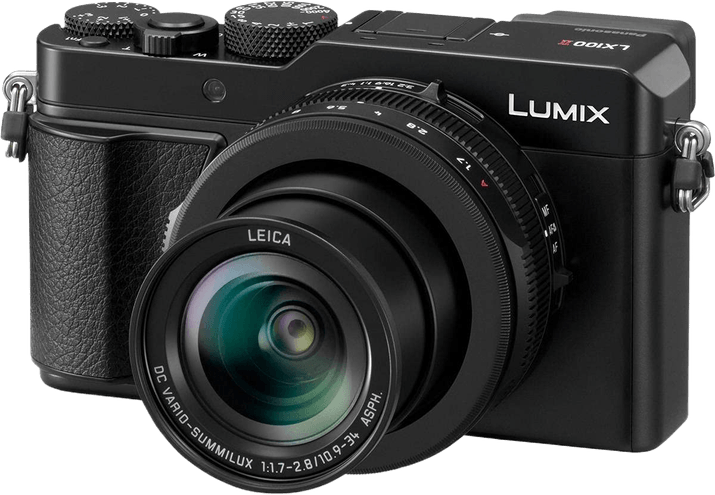
- Macro mode for stunning macro photography
- 4K video recording for stunning visuals
- Fast autofocus for capturing fast-moving subjects
- Variety of creative modes for artistic photography
- Built-in Wi-Fi and Bluetooth for easy sharing
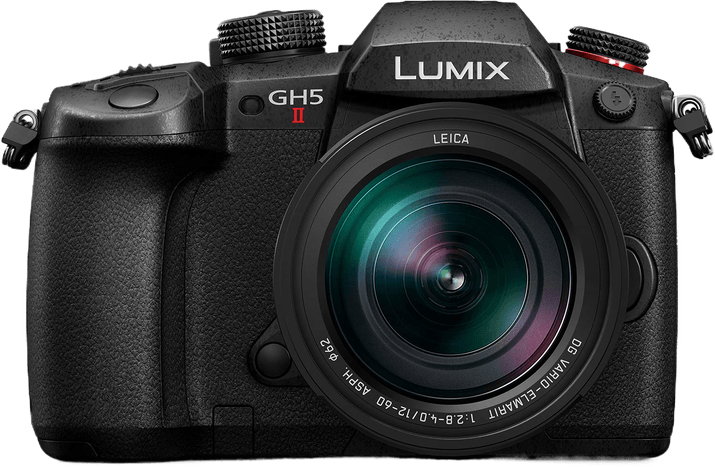
- Professional-grade camera ideal for videography
- 20.3 MP sensor and dual image stabilization
- Records 10-bit 4K / 60p and 4K / 30p video
- Ultra HD 4K recording at up to 60 fps
- Built-in Wi-Fi and Bluetooth for easy sharing

- 20.3 MP high-sensitivity 1/2.3” sensor
- 4K video, photo, and Post Focus mode
- 30x zoom lens
- 3" LCD touchscreen
- Wi-Fi and Bluetooth connectivity
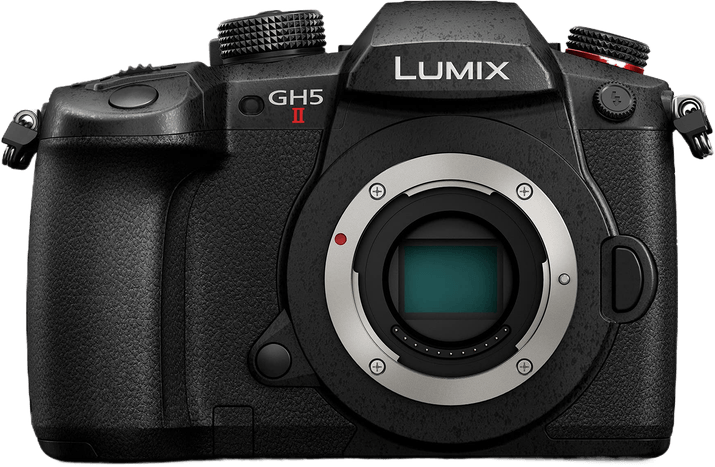
- 20.3 MP MFT sensor
- 4K Ultra HD video recording
- 5-axis Dual IS 2 image stabilization
- Tilting LCD touchscreen
- Wi-Fi and Bluetooth connectivity
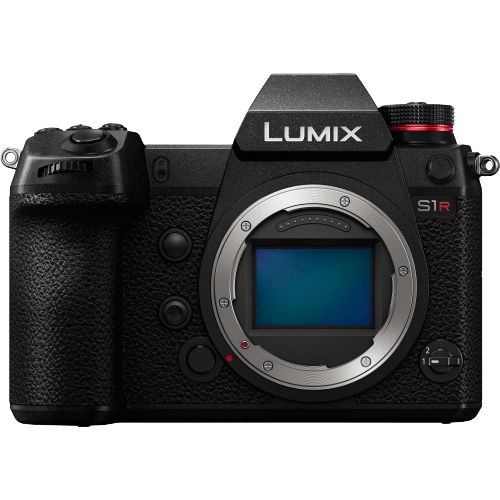
- 47 MP full frame sensor
- Outstanding high-resolution shot mode
- Fast autofocus and burst speed
- 5-axis dual image stabilization
- Robust weather sealing
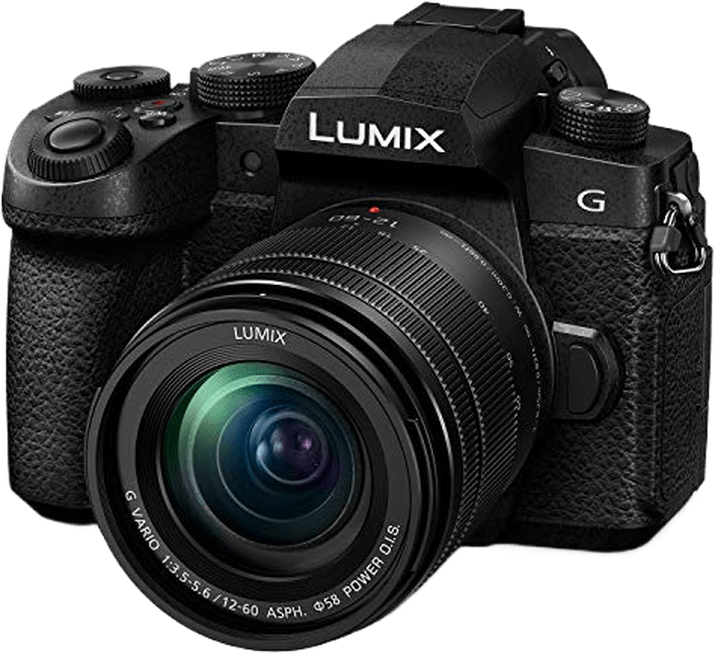
- 20.3 MP MFT entry-level mirrorless
- 4K video recording at up to 30 fps
- 5-axis dual image stabilization for stills and videos
- 5.5-stop Dual IS 2 for improved low-light shooting
- Built-in Wi-Fi and Bluetooth for remote control and image sharing
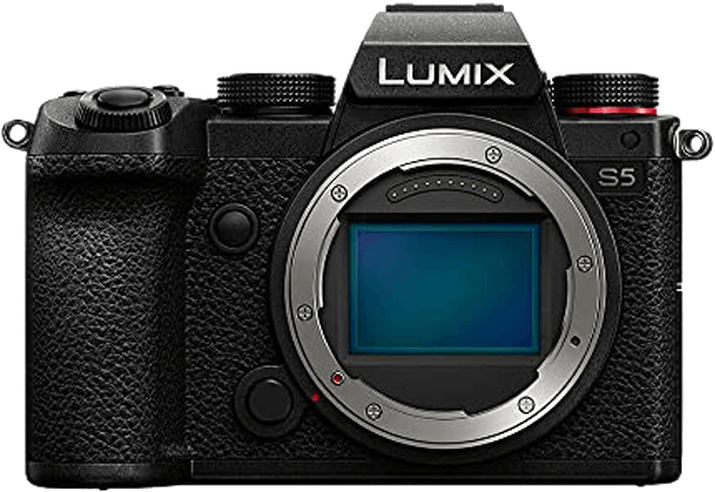
- 96 MP high-resolution shot mode
- 4K recording at 60 fps
- 180 fps slow-motion recording in Full HD
- Webcam functionality for high-res streaming
- Weather-sealed body for outdoor shooting
11 Best Panasonic Lumix Cameras
Choosing the best Panasonic camera is a difficult decision. Their compact cameras are class-leading machines. They specialize in Micro Four Thirds cameras. And the full frame mirrorless cameras are popular with professional media producers.
Finding the best one all depends on what you need. We’ll take you through our choices. So you can find the best Panasonic camera.
1. Panasonic Lumix GH6

| Released |
Released
2022
|
| Sensor Format |
Sensor Format
|
| Lens Mount |
Lens Mount
Micro 4/3
|
| Megapixels |
Megapixels
25 MP |
| Autofocus Points |
Autofocus Points
315 |
| Maximum ISO (Native) |
Maximum ISO (Native)
25,600 |
| Frame Rate |
Frame Rate
14 fps |
| In-body Stabilization |
In-body Stabilization
|
| Max Video Resolution |
Max Video Resolution
|
| Max Video Frame Rate |
Max Video Frame Rate
120 p
|
| Other Key Features |
Other Key Features
100 MP high-res shot mode, 4K at 120 fps, dynamic range booster, Full HD 300 fps slow-motion mode
|
| Best For |
Best For
Multimedia creators at all levels
|
The Panasonic Lumix GH6 is the ultimate hybrid camera. Panasonic has built its reputation on the quality of its photo and video features. But the GH6 outshines all the others. It exceeds the expectations of its MFT sensor.
It gives you awesome high-resolution images. And the video features let you create cinema-quality media. This Panasonic camera is bursting with multimedia technology.
The GH6 is armed with a Micro Four Thirds sensor. It’s a smaller sensor type that allows a more compact camera body. These cameras are ideal for your camera backpack.
Only Panasonic Lumix and Olympus make MFT cameras. And both sets of cameras use the same lens mount. That means you can use the best Olympus lenses with Panasonic MFT cameras. (You can read about the best Olympus cameras to compare.)
While small, the MFT sensor still gives you a 25 MP image resolution. This is excellent quality by any standard. And it’s enhanced by the dynamic range boost mode. This gives you +13 stops of dynamic range for more detailed shots.
Plus, the camera has five-axis image stabilization. This gives you sharper images and more control over your exposure settings.
If 25 MP isn’t enough, you can increase this fourfold. The GH6 has a high-resolution shot mode that gives you 100 MP images. That’s truly breathtaking image quality. It does this by taking several lower-res images and creating one composite. The result knocks your socks off.
The video features are just as impressive. It can record with a 5.2K video resolution. It’s a big step up from the 4K video we see in most hybrid cameras. And it’s close to cinema-quality footage. You also get a 60 fps frame rate at full resolution. That’s super-smooth high-res footage.
You can shoot 4K at 120 fps for even smoother results. And the 300 fps Full HD slow-motion mode is the best slow-mo in the business.
The electronic viewfinder is excellent. There’s a vari-angle touchscreen. You also get a hot shoe connector to connect a flash unit. And you can connect an XLR (external line return) microphone for professional audio recording.
The USB charging and built-in Wi-Fi are bonus features we all appreciate. And there are dual memory card slots for extra storage. The Lumix GH6 is a multimedia powerhouse with a compact body.
2. Panasonic Lumix S5 II

| Released |
Released
2023
|
| Sensor Format |
Sensor Format
Full Frame
|
| Lens Mount |
Lens Mount
Leica L
|
| Megapixels |
Megapixels
24 MP
|
| Autofocus Points |
Autofocus Points
779
|
| Maximum ISO (Native) |
Maximum ISO (Native)
51200
|
| Frame Rate |
Frame Rate
9 fps
|
| In-body Stabilization |
In-body Stabilization
1
|
| Max Video Resolution |
Max Video Resolution
6K
|
| Max Video Frame Rate |
Max Video Frame Rate
120 p
|
| Other Key Features |
Other Key Features
Active IS for videos, weather-sealed body, Real-time LUT for photos and videos
|
| Best For |
Best For
Multimedia pros looking for a full frame camera
|
The Panasonic Lumix S5 II is a state-of-the-art mirrorless camera. It has a powerful full frame sensor. It has a lightweight yet durable body. And it delivers hybrid camera results to the highest standard.
This Lumix camera has a full frame CMOS sensor. And it has a 24.2 MP image resolution. This might not sound like much for a full frame sensor. But the larger pixels give you increased dynamic range and sharper detail.
The built-in image stabilization also enhances the image quality. And the real-time LUT function enables in-camera color grading for more vibrant images. It works with photos and videos.
There’s no denying the popularity of the S5 II with filmmakers. And it’s easy to see why when you look at the video specs.
You can record glorious 6K videos with a 30 fps frame rate. You also have 4K at 60 fps for smoother video footage. Or you can drop to Full HD for a faster 120 fps recording speed.
The photography autofocus system is excellent. It has face-detection features. And it has fast and reliable subject tracking. But the video AF is on another level. The advanced subject tracking when recording is incredible. It locks onto your subject and doesn’t lose focus.
You also get the Active Image Stabilization feature. It gives you even more stability when shooting, walking, and tracking shots. You might not even need a camera gimbal.
There’s a 50 ISO setting for enhanced image quality. This is perfect for landscape photographers. It brings out the best in your fashion photography. And it’s a big help if you want to profit from portraits. That’s another reason this is such a versatile Panasonic camera.
It has Wi-Fi connectivity. The vari-angle LCD touchscreen gives you more freedom as a creator. And the dual card slots are essential in any pro camera. Plus, webcam functionality turns it into a high-res streaming camera. And the body is weather-sealed for outdoor shooting.
The Lumix S5 II is the best Panasonic full frame camera. It’s loaded with some of Panasonic’s most advanced technology!
3. Panasonic Lumix G100

| Released |
Released
2020
|
| Sensor Format |
Sensor Format
|
| Lens Mount |
Lens Mount
Micro 4/3
|
| Megapixels |
Megapixels
20 MP |
| Autofocus Points |
Autofocus Points
49 |
| Maximum ISO (Native) |
Maximum ISO (Native)
25,600 |
| Frame Rate |
Frame Rate
10 fps |
| In-body Stabilization |
In-body Stabilization
|
| Max Video Resolution |
Max Video Resolution
|
| Max Video Frame Rate |
Max Video Frame Rate
120 p
|
| Other Key Features |
Other Key Features
Webcam functionality, 360-degree audio tracking, video selfie mode
|
| Best For |
Best For
Content creators and vloggers
|
The Panasonic Lumix G100 is a compact multimedia camera. The small and lightweight body makes it a convenient camera for any photographer.
The fantastic hybrid features make it a good choice whether you’re into photography or video production. It has specialist features. And they make it the best Panasonic camera for vloggers and content creators.
This camera has a Micro Four Thirds sensor with 20.3 MP resolution. This might surprise many at first glance because it’s so small.
But don’t be fooled by the relatively low MP count. That’s a big step up from smartphone cameras. And it produces fabulous images with quality at another level completely.
The video features are perfect for content creators. You can record 4K footage at 30 fps. Smartphone videos don’t come close to that quality. You can also switch to Full HD for a faster 60 fps frame rate. There’s a special selfie video mode.
So it’s ideal for shooting vlogs. And the vertical orientation is perfect for social media.
The G100 also doubles as a webcam. This gives you 4K resolution live streaming options. (You can check out all the best 4K webcams). And you can rig it up with the best mini tripod for the perfect streaming setup.
The AF system has face detection and subject tracking. And these features also work when shooting video.
It also gives you advanced 360-degree audio tracking. It uses face detection technology to lock on to whoever’s speaking. It tracks them when they move, giving you directional audio. This is ideal for vlogs, live streams, and shooting movies.
This camera even has five-axis image stabilization. It improves low-light performance. And it gives you more exposure control. The rotating touchscreen helps you get the angles you need. And the Wi-Fi connectivity allows you to share media easily.
Content creators at all levels can’t go wrong with the Lumix G100. YouTubers and Instagrammers should also check out our articles on the best vlogging cameras and streaming cameras.
4. Panasonic Lumix FZ1000 II

| Released |
Released
2019
|
| Sensor Format |
Sensor Format
|
| Lens Mount |
Lens Mount
Fixed
|
| Megapixels |
Megapixels
20 MP |
| Autofocus Points |
Autofocus Points
49 |
| Maximum ISO (Native) |
Maximum ISO (Native)
12,800 |
| Frame Rate |
Frame Rate
12 fps |
| In-body Stabilization |
In-body Stabilization
|
| Max Video Resolution |
Max Video Resolution
|
| Max Video Frame Rate |
Max Video Frame Rate
60 p
|
| Other Key Features |
Other Key Features
Fixed Leica lens, optical stabilization, 16x optical zoom
|
| Best For |
Best For
Beginner and casual photographers
|
The Panasonic Lumix FZ1000 II is a fantastic bridge camera. Not only is it the best Panasonic camera in this category. It’s one of the best bridge cameras available. (You can review our full list of the best bridge cameras.)
A bridge camera is a cross between a compact and a DSLR camera. It’s the best of both worlds. And they’re great for beginners. It gives you all the manual controls of a DSLR. But it has a fixed camera lens. They are also very easy to use. So you can start shooting straight away.
This Lumix has a one-inch image sensor. This might sound small, but it gives you 20.1 MP images. It’s excellent quality for a sensor of that size. And it’s a big step up from smartphone camera quality. The best iPhone cameras don’t even come close.
The fixed lens comes from Leica. So there’s no question about quality. Its optical performance is excellent. It has a powerful 16x zoom range. And it’s an optical zoom. So you don’t lose quality when zooming in.
The FZ1000 II is sensitive to movement at long zoom ranges. But the built-in optical stabilizer counteracts camera shake. This gives you sharper images at all points in the range.
This is one of the best bridge cameras for video. You can record videos with a glorious 4K resolution. And this is with a 30 fps frame rate. You can also choose the 24 fps option to record in MP4. And you also get the 4K Photo mode. This lets you take stills from your 4K footage.
Photos only have an 8 MP resolution. But this mode gives you a 30 fps burst rate. This is comparable to sports photography cameras.
It has a fantastic electronic viewfinder. And the Live View display helps you with composition and shot construction. You have post-focus and focus-stacking modes. The AF system is terrific. And it has Wi-Fi connectivity to easily share media.
The Lumix FZ1000 II is the best Panasonic camera for beginners. It delivers fantastic photos even for inexperienced photographers. And its video features are the perfect introduction to modern videography.
5. Panasonic Lumix LX100 II

| Released |
Released
2018
|
| Sensor Format |
Sensor Format
|
| Lens Mount |
Lens Mount
Fixed
|
| Megapixels |
Megapixels
17 MP |
| Autofocus Points |
Autofocus Points
49 |
| Maximum ISO (Native) |
Maximum ISO (Native)
25,600 |
| Frame Rate |
Frame Rate
11 fps |
| In-body Stabilization |
In-body Stabilization
|
| Max Video Resolution |
Max Video Resolution
|
| Max Video Frame Rate |
Max Video Frame Rate
60 p
|
| Other Key Features |
Other Key Features
Multi-aspect modes, Fixed Leica lens, macro photography mode, remote shooting
|
| Best For |
Best For
Macro photographers, travel and YouTube videographers
|
The Panasonic Lumix LX100 II is a compact camera full of features. It might suit video makers more than photographers. But it is a portable camera that delivers consistently.
It’s the perfect camera for travel photography and videos. It’s a great choice for filming vlogs or other YouTube content. And it also has some satisfying photography features.
It’s a compact camera with an MFT sensor. And the sensor only gives you 17 MP. It’s not great compared to other cameras on our list. But you still get fabulous images with rich colors and sharp details. And it still beats smartphone cameras. So you still make a splash on social media.
The fixed Leica lens is excellent. It gives you crisp and clear results with optical image stabilization. And it gives you a 3x optical zoom.
The LX100 II also has a 3 cm minimum focus distance. This lets you use its fantastic macro camera mode. You can shoot intense close-ups of flowers, insects, and products. (If you like getting up close and personal, check out our Macro Magic photography course.)
The video features still compete at a high level. It gives you lovely 4K videos. And the frame rate of 30 fps gives smooth high-res footage.
You can shoot with faster frame rates if you drop down to lower resolutions. And you can also extract single frames and use them as still images. The image resolution is lower. But you won’t miss a thing with a 30 fps burst mode!
The Bluetooth and Wi-Fi connectivity helps you share media with other devices. And it also enables remote shooting. You can shoot photos or videos remotely using your smartphone. It’s a big help if you’re creating vlogs or other YouTube content like guitar tutorials.
The Lumix LX100 II is a brilliant multimedia machine. And it fits in your pocket!
6. Panasonic Lumix GH5 II

| Released |
Released
2021
|
| Sensor Format |
Sensor Format
Micro Four Thirds
|
| Lens Mount |
Lens Mount
Micro 4/3
|
| Megapixels |
Megapixels
20.33 MP
|
| Autofocus Points |
Autofocus Points
225
|
| Maximum ISO (Native) |
Maximum ISO (Native)
25600
|
| Frame Rate |
Frame Rate
12 fps
|
| In-body Stabilization |
In-body Stabilization
1
|
| Max Video Resolution |
Max Video Resolution
6K
|
| Max Video Frame Rate |
Max Video Frame Rate
30 p
|
| Other Key Features |
Other Key Features
Webcam functionality, in-camera presets, HDMI output, hot shoe for XLR microphone
|
| Best For |
Best For
Video producers, content creators, and live streamers
|
The Panasonic Lumix GH5 II is another multimedia powerhouse. It produces excellent photos. And it has fantastic photography features. But video recording is where the GH5 II really excels. And unlike the original GH5, the Mark II has live-streaming functionality.
It has everything you need to shoot pro-level movies. You get pristine 4K video quality. And there’s no time limit for video recording. You can shoot 4K at 60 fps for super-smooth footage. And you can use the HDMI output while recording.
The intelligent AF video tracking is a big improvement from the original GH5. It’s incredibly reliable, even with lots of action in the frame. Another big improvement is the webcam functionality. This allows you to live stream with a 4K resolution.
The GH5 II has an MFT sensor with a 20.3 MP resolution. It’s a really strong quality for an MFT camera. And the powerful image processor maximizes the image results.
The camera also has built-in picture styles and presets. And you can edit your images in-camera without needing photo editing software.
Its advanced image stabilization works with photos and videos. It gives you 6.5 stops of shake compensation. And it gives you smooth videos when shooting handheld. But you still might want to look at our list of the best video tripods.
Like all good hybrid cameras, the GH5 II has ports for headphones and microphones. There’s also a hot shoe for XLR microphones. The latter gives you excellent options for sound recording. It also has two memory card slots. And the electronic viewfinder is another highlight.
The Lumix GH5 II is one of the best Panasonic cameras for professional live streaming.
7. Panasonic Lumix ZS80

| Released |
Released
2019
|
| Sensor Format |
Sensor Format
|
| Lens Mount |
Lens Mount
Fixed
|
| Megapixels |
Megapixels
20 MP |
| Autofocus Points |
Autofocus Points
1 |
| Maximum ISO (Native) |
Maximum ISO (Native)
3,200 |
| Frame Rate |
Frame Rate
10 fps |
| In-body Stabilization |
In-body Stabilization
|
| Max Video Resolution |
Max Video Resolution
|
| Max Video Frame Rate |
Max Video Frame Rate
60 p
|
| Other Key Features |
Other Key Features
Fixed Leica lens, 30x zoom, optical stabilization, 4K photo mode
|
| Best For |
Best For
Photographers looking for a powerful compact camera
|
Compact cameras don’t get much better than the Panasonic Lumix ZS80. The small, sleek camera body fits in your pocket like any compact. But it’s packed with advanced features for photos and video. It has a powerful sensor, 4K recording, and an incredible zoom lens.
The ZS80 has a one-inch sensor. But the 20.3 MP resolution is impressive for a compact. And it puts smartphone cameras to shame.
Plus, the optical quality of the Leica lens is faultless. It gives you a powerful 30x zoom. And it even has optical stabilization to reduce camera shake.
Videographers will also get a kick out of this camera. It gives you 4K videos at 30 fps. And there’s a 120 fps option in Full HD. The latter is excellent for slow-motion videos.
The 4K photo mode allows you to use individual frames as images. They only have an 8 MP resolution. But you don’t get much better than a 30 fps continuous shooting mode. And it has plenty of shooting modes for different types of photography.
The LCD touchscreen tilts and rotates for easy viewing. And there’s a built-in electronic viewfinder. The camera has Bluetooth and Wi-Fi connectivity. And the USB charging is another bonus.
The Lumix ZS80 is one of the most all-around compact cameras on the market.
8. Panasonic Lumix S1R

| Released |
Released
2019
|
| Sensor Format |
Sensor Format
Full Frame
|
| Lens Mount |
Lens Mount
Leica L
|
| Megapixels |
Megapixels
47.3 MP
|
| Autofocus Points |
Autofocus Points
225
|
| Maximum ISO (Native) |
Maximum ISO (Native)
25600
|
| Frame Rate |
Frame Rate
9 fps
|
| In-body Stabilization |
In-body Stabilization
1
|
| Max Video Resolution |
Max Video Resolution
4K
|
| Max Video Frame Rate |
Max Video Frame Rate
60 p
|
| Other Key Features |
Other Key Features
6K photo functions
|
| Best For |
Best For
Professional photographers and videographers looking for a high-resolution camera
|
The Panasonic Lumix S1R is a beast of a mirrorless camera. It has a powerful full frame sensor. And it delivers genuinely breathtaking images. The video features are also excellent, as you’d expect from a Panasonic camera.
It isn’t a budget camera by any means. But it’s the best high-resolution camera from Panasonic Lumix.
The full frame sensor gives you a whopping 47.3 MP resolution. That’s one of the highest resolutions of any full frame camera. It’s close to the level of medium format cameras.
The color rendition is fantastic, with vibrant and true-to-life tones. And the dynamic range gives you intricate details in bright and dark areas. It also has a 50 ISO setting. So it’s a fantastic camera for landscape photography and fine art.
The S1R also has a high-resolution shot mode for unrivaled quality. It takes eight separate images. Then it puts them together to create one ultra-resolution image.
You do need a heavy-duty tripod. But the result is a photo with a resolution equivalent to 187 megapixels. That’s a 16,736 x 11,168-pixel RAW file. You’ll need the dual card slots when shooting in this mode.
Now it’s time for the movie makers to get excited. The 4K quality is outstanding. And you get full-resolution recording at 60 fps. This does have a time limit of 15 minutes. But 4K at 30 fps is unlimited.
You also get 180 fps in Full HD. This is perfect for super slow-motion video footage. And it makes it a great camera for skateboarding, sports events, and concerts.
It’s a super-high-tech camera. The vari-angle screen and electronic viewfinder make it a breeze to use. It has Wi-Fi connectivity. And it has all the necessary ports for headphones, monitors, and microphones.
The Panasonic Lumix S1R is a monster when it comes to hi-res images. The heavy price tag is the only reason it’s further down our list.
9. Panasonic Lumix GX9

| Released |
Released
2018
|
| Sensor Format |
Sensor Format
|
| Lens Mount |
Lens Mount
Micro 4/3
|
| Megapixels |
Megapixels
20 MP |
| Autofocus Points |
Autofocus Points
49 |
| Maximum ISO (Native) |
Maximum ISO (Native)
25,600 |
| Frame Rate |
Frame Rate
9 fps |
| In-body Stabilization |
In-body Stabilization
|
| Max Video Resolution |
Max Video Resolution
|
| Max Video Frame Rate |
Max Video Frame Rate
60 p
|
| Other Key Features |
Other Key Features
4K Photo mode, custom multi-AF mode, tilting touchscreen
|
| Best For |
Best For
Multimedia creators looking for a backup camera
|
The Panasonic Lumix GX9 is an older interchangeable lens camera. But it has a tidy, compact body you can slip into your camera messenger bag. And despite its age, it still produces brilliant photos and excellent videos.
It has a Micro Four Thirds sensor with a 20.3 MP resolution. The details are fantastic. And the colors are vibrant, true-to-life, and well-rendered. There are also focus-stacking and focus-bracketing modes. And the AF has face-detection options.
The native low ISO is only 200. But you can expand this to 100 ISO for better quality. And the five-axis image stabilization is a big bonus. The GX9 lets you shoot four stops slower with the shutter speed. And it gives you sharper images in low light.
You can record fantastic 4K video at 30 fps for top-quality footage. And you can record Full HD at 60 fps. Plus, the 4K Photo mode gives you a 30 fps burst mode. The images only have an 8 MP resolution. But it’s ideal for capturing fast action.
The camera has a built-in viewfinder for better composition. And the LCD touchscreen has a good range of movement. So you can get the shot you need. It has Wi-Fi and Bluetooth connectivity.
The Lumix GX9 remains one of the best Panasonic cameras you can find.
10. Panasonic Lumix G95

| Released |
Released
2019
|
| Sensor Format |
Sensor Format
Micro Four Thirds
|
| Lens Mount |
Lens Mount
Micro 4/3
|
| Megapixels |
Megapixels
20 MP
|
| Autofocus Points |
Autofocus Points
49
|
| Maximum ISO (Native) |
Maximum ISO (Native)
25600
|
| Frame Rate |
Frame Rate
9 fps
|
| In-body Stabilization |
In-body Stabilization
1
|
| Max Video Resolution |
Max Video Resolution
4K
|
| Max Video Frame Rate |
Max Video Frame Rate
120 p
|
| Other Key Features |
Other Key Features
Built-in flash, Live View Composite mode, post-focus mode, weather-sealed body
|
| Best For |
Best For
Beginner photographers looking for a good value camera
|
The Panasonic Lumix G95 is another fantastic MFT camera. It’s an entry-level Panasonic camera with a more-than-reasonable price tag. With excellent features for photos and videos, it is a great camera to start creating media with.
The MFT sensor gives you a strong resolution of 20.3 MP. That gives you beautiful images with bright colors and sharp details. The dynamic range is outstanding for a camera at this level. And it has five-axis image stabilization built in.
The photography features give you complete creative control. Live View Composite mode lets you construct one image from many exposures. Post-focus mode lets you change the focus point in your image after you’ve taken it. And you have focus-stacking options.
Budding filmmakers will love the 4K video recording. You can shoot with a 4K resolution at 30 fps. And you can shoot Full HD at 120 fps.
Its face-detection AF is excellent for all types of videos. And the rotating LCD screen makes it easy to shoot vlogs. The camera also has built-in time-lapse video features. So it’s one of the best cameras for time-lapse photography.
The battery life isn’t the most reliable, especially when shooting video. It’s the main drawback of a camera that punches above its weight. But it has a tough and durable body. And it has all the features young creatives need to get started.
The Lumix G95 is a high-tech camera for beginners. And the price makes it too good to miss out on!
11. Panasonic Lumix S5

| Released |
Released
2021
|
| Sensor Format |
Sensor Format
|
| Lens Mount |
Lens Mount
Leica L
|
| Megapixels |
Megapixels
24.2 MP |
| Autofocus Points |
Autofocus Points
225 |
| Maximum ISO (Native) |
Maximum ISO (Native)
51,200 |
| Frame Rate |
Frame Rate
7 fps |
| In-body Stabilization |
In-body Stabilization
|
| Max Video Resolution |
Max Video Resolution
|
| Max Video Frame Rate |
Max Video Frame Rate
60 p
|
| Other Key Features |
Other Key Features
Dual-native ISO, high-resolution mode, weather-sealed
|
| Best For |
Best For
Photographers and videographers looking for a good-value full frame camera
|
The Panasonic Lumix S5 is the original version of the S5 II featured earlier on our list. While this is the older model, it still has excellent hybrid features. You can produce professional media, including high-resolution photos and videos.
This full frame camera has a resolution of 24.2 MP. The dynamic range is excellent. And the low-light performance is enhanced by its built-in image stabilization. This gives you 6.5 stops of shutter compensation.
This Lumix also has a high-resolution shot mode if you need more power. It takes several shots and puts them together as one image.
The resulting image has a resolution equivalent to 96 MP. So it gives you breathtaking detail and sharpness. And it’s a fantastic option for landscape photography. (Any landscape enthusiasts should check out our Epic Landscape Editing video course.)
The Panasonic S5 is ideal for creating cinematic videos. You can shoot in glorious 4K with a frame rate of 60 fps. This is sharp, vibrant, and smooth footage. Plus, the video isn’t cropped. And there’s no recording time limit!
There’s also a 180 fps Full HD slow-motion capture. This makes it an ideal slow-mo camera for music videos or sporting events. And it can be used as a high-resolution webcam for professional vlogging and streaming. Plus, it has a vari-angle touchscreen and ports for audio equipment.
The Lumix S5 is one of Panasonic’s classic hybrid cameras. And because it’s an older model, the price is a bit more budget-friendly. So it is worth every penny for media creators.
FAQs About the Best Panasonic Cameras
We’ve answered some of the most-asked questions about Panasonic cameras. We hope it helps you decide if a Panasonic camera is right for you!
Why Choose Panasonic Lumix Cameras?
Panasonic cameras don’t have the same brand recognition as Canon cameras or Nikon cameras. The latter dominate the photography world. And Sony has also always been a big-name player in mirrorless cameras.
But Panasonic is a specialist brand that focuses on a specific type of camera. Panasonic makes hybrid cameras.
Hybrid cameras have features for both photography and videography. You can take stunning photographs. And you can shoot high-quality videos with the same camera.
Video recording has become essential to a photographer’s workload. So Panasonic cameras are all packed with advanced features for video and not just photos. Even their beginner cameras have quality video functions.
Many professional photographers need to be able to produce photos and videos at a high standard. And video has grown to become a powerful social media presence. That’s why Panasonic Lumix cameras are worth your consideration.

What Types of Cameras Does Panasonic Make?
While Panasonic specializes in hybrid cameras, the type of cameras they produce varies. Along with Olympus cameras, there are excellent Panasonic options for Micro Four Thirds cameras. The smaller sensor allows for a more compact body.
But Panasonic also has bridge cameras and compact cameras for beginners. And they have full frame mirrorless cameras for professionals. So they have a camera for all types of multimedia creators.
What Is the Best Panasonic Lumix Camera for Video?
All the best Panasonic cameras have excellent video features. But the Panasonic Lumix GH6 holds a place above the others. It’s an MFT camera with some of the most advanced features on the market. And despite its small size, it delivers professional cinematic results.
The Lumix S5 II is the best full frame Panasonic camera for video. You can make everything from chart-topping music videos to Palm d’Or-winning movies. It has a professional price tag. But it produces media at the highest professional standard.
The Panasonic G100 is the best for vlogging, streaming, and casual filmmaking. It’s a compact camera with top video features. And many of the features are geared toward influencers and YouTube streamers. It’s the perfect camera for social media videos.
Conclusion: The Best Panasonic Lumix Camera
The best Panasonic cameras give you outstanding features for photography and videography. They are hybrid camera specialists. And as we’ve seen from the cameras on our list, Panasonic delivers on that promise. You can create stunning media with any of these Panasonic Lumix cameras. And there’s a camera for every budget and skill level.
The Panasonic Lumix GH6 is the best Panasonic camera out there. Its photo results are staggering for an MFT camera. And video production is at another level completely. It’s a compact camera that packs a punch. And it’s the ultimate hybrid camera.

